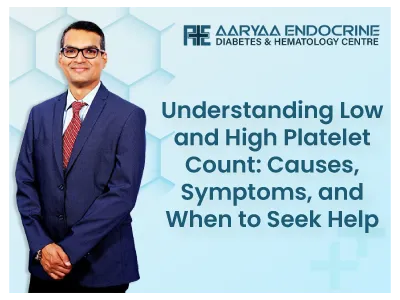What is Low Platelet Count and How to Manage It

Our blood is a complex system with multiple components working together to maintain our health. Among these, platelets—tiny blood cells responsible for clotting—play a crucial role. When platelet levels become abnormally low (thrombocytopenia) or high (thrombocytosis), it can lead to a variety of health problems, ranging from unexpected bleeding to life-threatening clots. Understanding what these conditions mean, what causes them, and when to seek help is vital for long-term well-being.
In this blog, we’ll explore the full spectrum of low and high platelet count, their causes, symptoms, and the steps you should take if you're affected. We’ll also guide you through when to seek medical help and how to better manage these conditions with expert care at Aaryaa Endocrine.
What Is a Low Platelet Count (Thrombocytopenia)?
A low platelet count—also called thrombocytopenia—occurs when the platelet counts in your blood drops below the normal range, typically under 150,000 platelets per microliter of blood. Platelets help in forming clots to stop bleeding. When you don't have enough platelets, even a small injury can lead to serious bleeding.
Causes of Thrombocytopenia
The reasons for thrombocytopenia can vary widely. The most common causes fall into three major categories:
Reduced Platelet Production
Some conditions interfere with the bone marrow’s ability to produce platelets. This may include:
- Viral infections like hepatitis or HIV
- Leukemia and other cancers
- Certain medications like chemotherapy
- Alcohol abuse
Increased Platelet Destruction
In some cases, the body destroys platelets faster than they can be produced. This is often due to:
- Autoimmune diseases such as lupus or immune thrombocytopenia (ITP)
- Bacterial sepsis or viral infections
- Reactions to certain drugs
Trapping of Platelets in the Spleen
An enlarged spleen can start storing more platelets than normal, reducing the number of circulating platelets in the blood.
Symptoms of Low Platelet Count
Thrombocytopenia can often go unnoticed, especially in mild cases. However, when the count drops significantly, symptoms may appear, such as:
- Frequent or easy bruising
- Prolonged bleeding from minor cuts
- Nosebleeds or bleeding gums
- Blood in urine or stool
- Heavy menstrual cycles
- Tiny red or purple dots (petechiae) on the skin
When to Seek Help
You should seek medical attention immediately if you experience:
- Unexpected bleeding or bruising
- Blood in vomit or stool
- Persistent fatigue with fever or infection
- A known history of autoimmune or blood disorders
Regular blood tests are key in tracking platelet counts, especially if you’re at risk due to medical treatments or chronic illnesses.
What Is a High Platelet Count (Thrombocytosis)?
A high platelet count—known as thrombocytosis—occurs when the platelet count exceeds 450,000 per microliter. It can either be a temporary response to another condition (reactive thrombocytosis) or a primary bone marrow disorder (essential thrombocythemia).
Causes of Thrombocytosis
There are two primary categories of high platelet count disorders:
Reactive Thrombocytosis
This type is more common and usually a result of another condition:
- Infections or inflammations
- Iron deficiency anemia
- Recovery from surgery or trauma
- Cancer or recent spleen removal
Primary or Essential Thrombocythemia
A rare condition where the bone marrow produces platelets excessively without any trigger. It is often associated with genetic mutations and may increase the risk of clots and strokes.
Symptoms of High Platelet Count
Many people with thrombocytosis don’t show any symptoms, and the condition is often discovered through routine blood tests. When symptoms do appear, they are often related to abnormal clotting:
- Headaches or dizziness
- Chest pain or shortness of breath
- Weakness, numbness, or visual disturbances
- Redness, warmth, or swelling in limbs (signs of deep vein thrombosis)
- In rare cases, bleeding may also occur
When to Seek Help
High platelet counts should not be ignored. Seek immediate care if you notice:
- Sudden chest pain or difficulty breathing
- Slurred speech or vision changes
- Unusual limb pain or swelling
- Any symptoms related to stroke or heart attack
Your healthcare provider may recommend further testing like genetic studies, bone marrow biopsy, or clotting function analysis based on your symptoms and medical history.
How Platelet Counts Are Diagnosed
The first step in diagnosing low or high platelet count is a Complete Blood Count (CBC) test. If abnormalities are detected, your doctor may order more test
- Peripheral blood smear
- Bone marrow biopsy
- Genetic testing (for primary thrombocytosis)
- Liver and kidney function tests
- Immune marker screening
Depending on results, a treatment plan may involve observation, medication, lifestyle changes, or referrals to hematology/endocrinology specialists.
Managing Platelet Disorders: What Can Help?
For Thrombocytopenia:
- Avoid alcohol and drugs that can affect platelets
- Manage underlying infections or autoimmune diseases
- Platelet transfusions (in severe cases)
For Thrombocytosis:
- Medications like aspirin or hydroxyurea (for primary forms)
- Treatment of the root cause (e.g., infection or inflammation)
- Blood donation (in certain extreme cases)
Maintaining a balanced diet, managing stress, and regular check-ups play an important role in stabilizing platelet counts and preventing complications.
Why Choose Aaryaa Endocrine?
At Aaryaa Endocrine, we specialize in diagnosing and treating complex platelet count disorders with precision and personalized care. Our expert team combines advanced diagnostic tools, detailed patient history, and evidence-based treatment strategies to guide you at every step. Whether you're dealing with thrombocytopenia or thrombocytosis, our collaborative approach helps identify the root cause and create a treatment plan tailored to your needs. We prioritize patient education, early diagnosis, and long-term management to help you live a healthier, safer life. When it comes to your blood health, expert care is just a call away.
Conclusion
Understanding the causes and symptoms of low and high platelet count is crucial for timely intervention and prevention of serious complications. From excessive bruising to blood clots, these conditions can present differently in everyone. Whether it’s thrombocytopenia or thrombocytosis, the right knowledge and care can make all the difference. If you experience any symptoms or have concerns about your platelet levels, don’t delay. Early diagnosis and expert care at Aaryaa Endocrine can help you manage these disorders effectively and live a healthier life.


